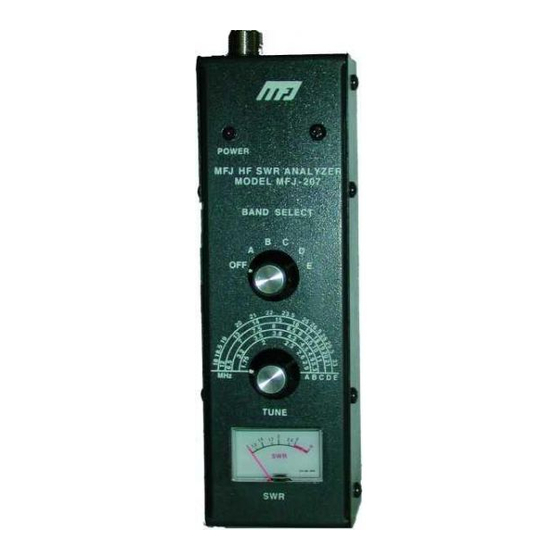
Table of Contents
Advertisement
Quick Links
Thank you for purchasing the MFJ-207 HF/VHF SWR Analyzer.
The MFJ-207 gives you a direct readout of your antenna's SWR
without the need for formulas or indirect readings. The MFJ-207
can also be used to adjust a tuner to match your antenna without
the need for transmitting. The frequency coverage for the MFJ-207
is approximately from 1.75 MHz to 30 MHz in five bands. This
provides a very smooth reading of SWR at high frequencies. The
coverage for each band may slightly vary from the coverage labled
on the cover. The bands and coverage are:
The MFJ-207 requires the optional MFJ-1312B power supply
adapter or a nine-volt transistor battery. A power supply may
also be used by connecting a 2.1 mm plug to the cable with
the positive wire connected to the center pin and the ground
wire connected to the outer pin.
************************************************************
NOTE: If you use a battery with the MFJ-207, use * an ALKALINE
nine-volt battery.
************************************************************
To install batteries, remove the screws holding the cover
onto the case. Insert the batteries into the battery holder.
Tuck the battery snap wires out of the way so they do not
interfere with the tuning capacitor rotation. Reinstall the
cover and screws. The dial calibration is only approximate and
is for reference only. A frequency counter can be connected to
the FREQ. OUT jack (RCA phono) to get a more accurate reading
of the frequency. As an alternative to a frequency counter,
you
can
zero
APPENDIX A.
USING THE MFJ-207 HF/VHF SWR ANALYZER
Your MFJ-207 HF/VHF SWR Analyzer has many uses. It can be
used to find the resonant frequency of your antenna, to find the
SWR of your antenna at a particular frequency, and
find the frequency at which your antenna has the lowest SWR. You
can also use the SWR Analyzer to adjust your antenna to a low SWR
and to adjust an antenna tuner to match the transmitter to the
line.
Measurement of the antenna's SWR is done
input to the transmission line. There is no need to climb the
tower and measure the SWR at the antenna. Using the chart in
Figure 3, and knowing the line loss for your transmission line
and the SWR at the line input, you can determine the SWR at
the antenna, regardless of line length.
MFJ-207 HF/VHF SWR Analyzer
BAND A
1.75 -
BAND B
3.00 -
BAND C
6.50 -
BAND D
11.65 -
BAND E
18.00 -
beat
the
output
Page 2
3.00
MHz
5.00
MHz
11.70
MHz
20.00
MHz
30.00
MHz
with
an
HF
receiver.
.
*
See
right at the
Advertisement
Table of Contents

Summary of Contents for MFJ MFJ-207
- Page 1 ************************************************************ NOTE: If you use a battery with the MFJ-207, use * an ALKALINE nine-volt battery. ************************************************************ To install batteries, remove the screws holding the cover onto the case.
- Page 2 II. Find the frequency at which the antenna has the lowest SWR. 1. Connect the antenna to the MFJ-207 as in step I. 2. Turn the BAND switch to the appropriate band. 3. Adjust the TUNE control throughout its range until the SWR meter reads its lowest value.
- Page 3 6. Turn the Band Switch to OFF when finished . *********************************************************** CAUTION * Never transmit through the MFJ-207. Take the MFJ-207 completely out of line before transmitting! Damage to your MFJ-207 will result if left in line. *********************************************************** Page 2...
- Page 4 We recommend using the MFJ-1702 coax switch as in the diagram below: Figure 1 - Hook-up for Using Analyzer to Tune Antenna Tuner. WARNING - Never transmit while the MFJ-1702 coax switch is switched to A if the xmitter is connected to B.
- Page 5 That means the radio frequency is set to the exact frequency of the MFJ-207. Now make a note of where the dial is set to on the MFJ-207 so you can re-set the frequency if you accidentally bump the TUNE control.
- Page 7 APPENDIX C Facts About Transmission Lines and Line Loss. The MFJ-207 should be connected to the input to the trans- mission line looking toward load. You do NOT have to know the length in wavelength of your transmission line, but you...
















Need help?
Do you have a question about the MFJ-207 and is the answer not in the manual?
Questions and answers